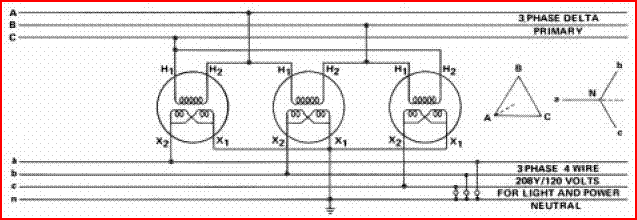vinod
Senior Member
- Location
- Saudi Arabia
Please help me,
What is the max % of allowable current unbalance in lighting transformer?
What is the max % of allowable current unbalance in lighting transformer?
Transformer data: voltage, phases, configuration, kVA...?Please help me,
What is the max % of allowable current unbalance in lighting transformer?
Transformer data: voltage, phases, configuration, kVA...?
Are we talking line current imbalance or lighting load to non-lighting load current imbalance as in the case of delta high leg bank comprised of lighter and stinger pot(s)?
It's unbalanced but not enough for there to be any concern....
As of this figure , is this panel current unbalanced?
I do not know of any for a wye secondary.Thanks,
Do you know any criteria for the maximum % unbalance current?
I do not know of any for a wye secondary.
I think I figured it out.If you have a WYE secondary and a DELTA primary, what exactly happens to the unbalanced current?
So given Ias, Ibs, and Ics, as the currents on each secondary line conductor of the wye system, what becomes Iap, Ibp and Icp for the primary line currents?
Man... it's difficult trying to keep up with all the different nomenclature used on this board. :blink:I think I figured it out.
Secondary coil A is connected to primary coil AB
Secondary coil B is connected to primary coil BC
Secondary coil C is connected to primary coil CA
n is the turns ratio between coils, which would be 4 for 120/208V secondary to 480V primary.
Therefore
Iabp = Ias/n
Ibcp = Ibs/n
Icap = Ics/n
Which would mean:
Ia = sqrt(Iabp^2 + Icap^2 + Iabp*Icap)
Ib = sqrt(Iabp^2 + Ibcp^2 + Iabp*Ibcp)
Ic = sqrt(Icap^2 + Ibcp^2 + Iabp*Icap)

voltage, phases, configuration, kVA...?
V= 480/ 208-120
Phase= 3ph
Connection = Delta /star
KVA = 45KVA
this is a lighting system see attachment.
I have asked about the % of UB current in total load. i.e R-N=74, Y-N= 80.3, B-N=84.8.
As of this figure , is this panel current unbalanced?
not an issue
first the load is low, <30 kva (8.9, 9.6, 10.2), utility won't care or even notice
avg is 9.6... -0.7, +0.6, about +/- 7%
very low N current (assuming all 3 ph have ~ the same pf)
you could go 15, 15, 0, as others have said only an issue if it causes an voltage imbalance
In a Delta/Wye transformer, there is an effect of balancing the load side imbalance to the line side.
I have asked about the % of UB current in total load. i.e R-N=74, Y-N= 80.3, B-N=84.8.
As of this figure , is this panel current unbalanced?
InjunEar...
The extreme distribution you propose seriously impacts neutral current,In! In addition, it results in a circulating-current of ~ 16% in the Xfmr's Prim'y-winding !
Phil Corso
If you have a WYE secondary and a DELTA primary, what exactly happens to the unbalanced current?
So given Ias, Ibs, and Ics, as the currents on each secondary line conductor of the wye system, what becomes Iap, Ibp and Icp for the primary line currents?
Thanks, Do you know any criteria for the maximum % unbalance current?
Carultch...
1) The currents in the Sec'y or Wye-winding, equal, in both magnitude and power-factor angle, the load currents!
2) The Prim'y or Delta-Winding currents are proportional to the Sec'y winding-current divided by the Xfmr's Turns ratio' i.e., 480/120=4! But, because of the D-Y arrangement, the PF angle is shifted by 30 deg!
3) The line-currents, then are the vector difference of Xfm's D-winding currents! That is, Line-Current, IA = IAB-IBC, IB = IBC-ICA, and IC = ICA-IAB!
Phil Corso
